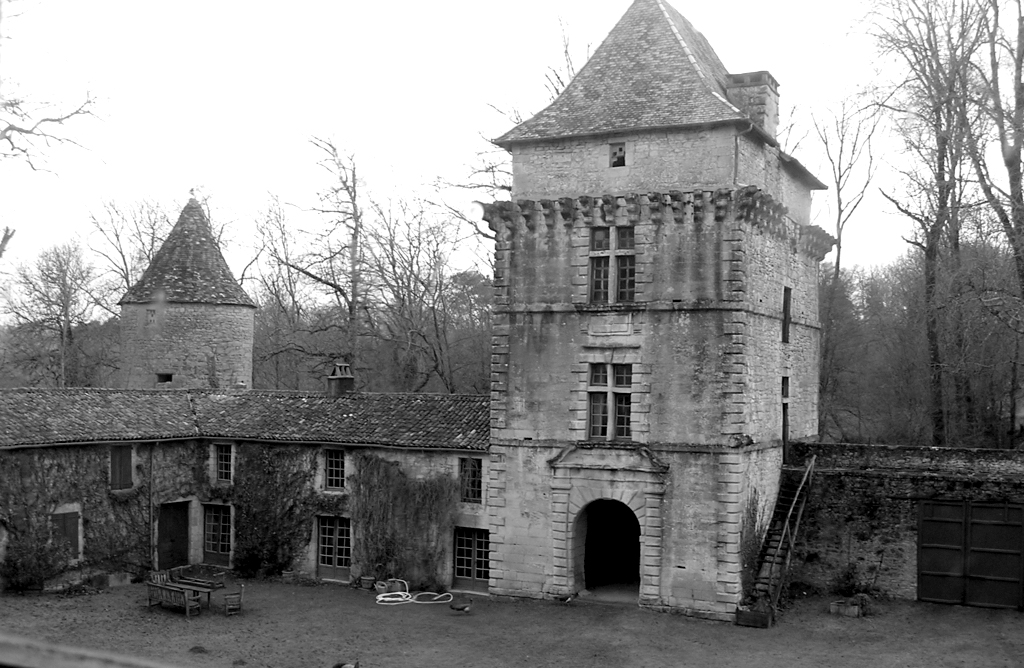
My first trip to France with John was not long after we met and he asked me to go to Paris for New Year’s, an invitation he didn’t need to repeat. I loved Paris; I was 16 years old, an exchange student, when it became my favorite city for life. New Year’s Eve in Paris, mais oui – city of lights, a golden, glittering Eiffel Tower and champagne on the blue-lit ChampsÉlysée. We arrived the day after Christmas in the middle of a snowstorm and stayed with Patrick and Ulla in the Sentier quarter. That night, after a rich French dinner and good red wine, we climbed to their rooftop terrace to watch the steep roofs cover with snow and they told us about their New Year’s plans to go to Jacques’ castle in thePérigord. A few days later we were on a train with them and their two little boys, heading south to the Périgord.
Jacques’ castle was the quintessential medieval French chateau: built for defense in the 13th century, it had two turret towers on either side of a crenellated gatehouse where centuries ago a drawbridge crossed a moat; stonewalls safeguarded a large courtyard, a manor house and service buildings. Over the New Year’s weekend, nine of us occupied the original keep, close to the kitchen and enormous fireplace that was our continuous source of heat and where we prepared and ate our meals. We consumed vast quantities of Périgordian food; most memorable were potatoes browned in goose fat, served with garlic and parsley. In the evening in front of a fire in the dining room, we sampled Jacques’ cave of local digestifs and Armagnac. The castle has been in his family from the beginning, handed down in matrilineal succession – many coats of arms hanging on the terracotta-colored dining room walls. In parts of the castle I found decades-old still-lifes: a book opened to a dust-covered page, maybe 50 years ago, on an ornate side table in the second floor grand hall; a wrack hung with fencing masks, several stacked cap and ball rifles and a rusty hanging scale, probably for measuring shot. The abundance of space and material history contrasted with the sparse Brooklyn loft John and I shared in our new life together. We were enchanted.
We explored the wooded countryside and visited well-preserved Périgordian bastides, 13th century towns developed by both French and English kings, first for agricultural commerce and later military defense – medieval Levittowns. They were laid out in a symmetrical grid with a central arcaded market, now filled with the inevitable tourist boutiques and real estate offices for the tourism boom. It was off-season, so we had much of the Périgord to ourselves.
After the holidays, John and I rented a car and drove east to Cahors, limestone cliffs and a wilder paysage. Smitten with southwestern France, we returned to the Périgord in May and again in October and visited the prehistoric cave paintings at Font-de-Gaume, Les Combarelles and Rouffignac. The exquisite, but enigmatic paintings, 25,000-15,000 years old, hold their own with paintings in the Louvre, Uffizi and the Met. Their astonishing beauty inspired John, an abstract painter. Not many artists he knew in New York had seen this art, so he started planning a painting class in the Périgord, integrating the cave art. He had taught classes in Italy, in Umbria and Matera, but never in France. When we got back to the US, we put out feelers, and soon the class was scheduled for the following fall and completely booked. Another chance to return to the Périgord.